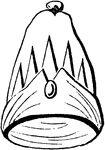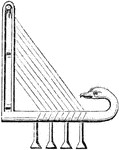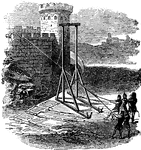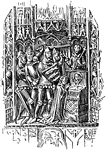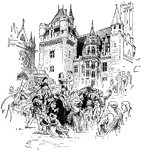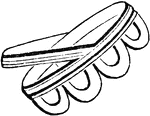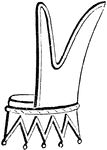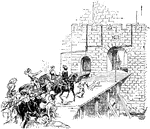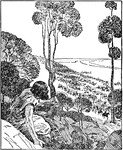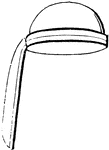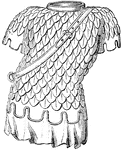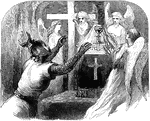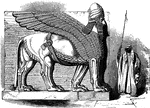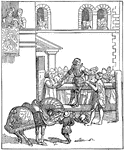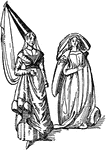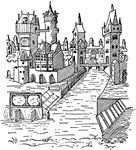The Miscellaneous Medieval Illustrations ClipArt gallery offers 84 illustrations of life in the Middle Ages.

An 11th Century Norman Castle, Aerial View
Illustration of an aerial view of an 11th century Norman castle in Europe. From this view, it is possible…
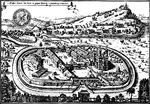
A German Benedictine Monastery with a Small Town in the Background - Aerial View
An aerial view of a German Benedictine Monastery compound. A small town is nestled at the foot of a…

A Medieval Shop, Storefront
Illustration of the storefront of a medieval shop on a street with buildings on either side. Spires…
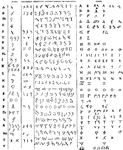
Alphabet of Antiquity
Leading alphabet of antiquity. Included is Punic (Western Semitic from Carthage, North Africa - now…

An English King from the 9th or 10th Century, Possibly King Alfred
Illustration of an English king between AD 800 and 1000. The king is very likely King Alfred who reigned…

Anglo-Saxon Candle Lantern Called a Lanthorn
A primitive candle lantern originally made by the Anglo-Saxons during the time of Alfred the Great.…

Anglo-Saxon Female Costume from 10th Century England
A woman stands in several layers of clothing. The dress usually included a cloak, an overdress, an under-dress,…

Anglo-Saxon Manor House, Circa 11th Century
Illustration of an Anglo-Saxon manor house or noble's house from 11th century England. There are several…

The Amphitheater at Arles
"The amphitheater was made a fortress, packed with houses, in the eighth century, on account of Saracen…

Bishop's Staff - Head with Serpent Design
Illustration of the head of a bishop's staff, also called a crosier. The head is a serpent curled around…

Carnarvon Castle
"This fortress was founded by Edward I in 1283. It is one of the most impressive of the decayed medieval…
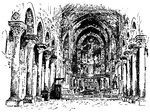
Cathedral of Monreale - Interior View
Illustration of the Cathedral at Monreale, near Palermo. It is an example of Sicilian and Norman architecture.…
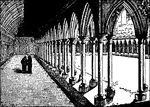
A Cloister at a French Monastery from the Middle Ages
This illustration shows one fragment of a French cloister built in the Middle Ages. The architecture…
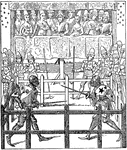
Trial by Combat
"The trial by combat, or wager of battle, was a solemn judicial duel. It was resorted to in the belief…
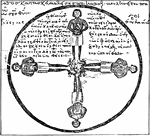
The Antipodes in Derision
"Cosmas lived in the sixth Christian century. In the cut here reproduced from his Topography, he ridicules…

Domesday Book
"There are two large volumes of the survey, one being a folio of 760 pages and the other a large octavo…
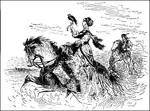
Falconry as Practiced by a Noblewoman of the Middle Ages on Horseback
A high-born, noblewoman rides a stallion while holding a falcon perched on her right hand. She is wearing…

Gauntlet
The Gauntlet is a piece of protective armor for the hand, dating back to the 12th century. The first…

A German Town on the Main River, Possibly Würzburg
Illustration of a town in Germany during the late Middle Ages, or medieval period. The town sits on…

The Gold Alfred Jewel, Front View
A close-up, front view of the gold Alfred Jewel, which was made in the late 9th century. The inscription…
The Gold Alfred Jewel, Side View
A close-up, side view of the gold Alfred Jewel, which was made in the late 9th century. The inscription…

Grinding with a Handmill
"Grinding with a hand-mill in the fourteenth century, as pictured in an old manuscript."—Gordy, 1912

Harrowing a Field for Farming in the Middle Ages
Two young men prepare the field using a simple harrow pulled by a horse. One man follows behind the…
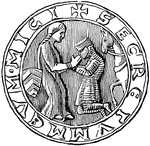
The Ceremony of Homage
"A fief was conferred by a very solemn and peculiar ceremony called homage. The person about to become…
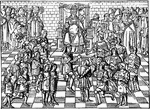
Pope Urban II
"Pope Urban II presiding over the council of Clermont in 1095 and calling the Christian people to the…
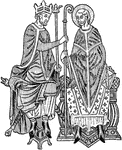
Investiture
"Investiture of a bishop by a king through the giving of the crosier, or pastoral staff."—Myers, 1905
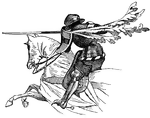
A Knight on Horseback, Wearing a Woman's Sleeve as a Favor
Illustration of a knight, riding a horse at full gallop, carrying a javelin and wearing full armor.…

Arming a Knight
"At the age of twenty-one the squire became a knight, being then introduced to the order of knighthood…
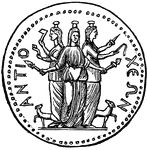
Medal of Antioch
A medal of Antioch engraved with an image of Nemesis, the goddess of divine punishment.

Medal of Aradus
A medal of Aradus depicting a fly on one side, which appears to commemorate Jupiter. The other side…
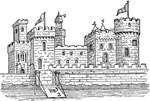
Medieval Castle
Medieval Castle of the Holy Roman Empire. "1 Moat, 2 Drawbridge, 3 Wicket, 4 Merlons, 5 Embrasures,…
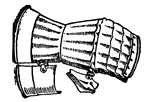
Mitten (Armor)
The 'mitten' superseded the gauntlet of the 14th century. Rather than having separate, unjointed fingers,…
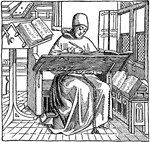
Monk Copyist
"The monks also became copyists, and with great painstaking and industry gathered and multiplied ancient…
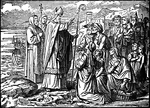
Saint Patrick Blesses the Irish and Banishes Snakes
Illustration of Saint Patrick on the shores of Ireland, with bishop's miter and crosier, and other clergy…

Peasants Using Mallets to Break Clods of Earth Before Farming the Land
Two medieval peasants, a man and woman, break clods of earth apart with mallets. The man is swinging…
Plowing in the Middle Ages
A scene from the Middle Ages, in which two people are plowing their land. One drives the oxen with a…

Reaping Grain the 14th Century
Men and women reap the grain from a field in the 14th century. Two women are bent over using sickles…

The Remains of the Prow of the Viking Ship Gokstad
The ship is pictured as it looked shortly after being unearthed. The tent-like structure at the back…
